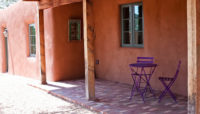The wallboard industry often refers to two types of fire-rated gypsum panels — Type X and Type C. Understanding the differences between these two fire-rated panels is important: Incorrect installation or choosing the wrong panel for your specific building application, and problems can arise. Simple mistakes can not only result in monetary losses, but safety issues.
Here’s why.
At the end of a project, all parties involved with the job want to be sure that the building occupants — and the integrity of the building — are safe during a disaster, such as a fire. Fire-rated gypsum panels increase the ability of assemblies to resist fire longer than regular gypsum board. The fibers in Type C and Type X gypsum panels both reduce the severity of cracks when exposed to flames or heat from a fire, which may increase the amount of time they perform without failure under these types of conditions. However, the boards are not the same, and product performance varies between the two types.
Let’s examine the differences: Type X gypsum board is defined by ASTM C1396 and generally requires a fire-resistance rating of not less than one hour for 5⁄8” thick boards or 45 minutes for ½” boards. Type C is an industry phrase to designate enhanced gypsum panels that exceed the requirements for Type X gypsum board in ASTM C1396. Type C panels typically have a shrinkage-compensating additive and when exposed to heat, the Type C gypsum board expands which provides more fire-resistance at the joints and seams. This is called “swelling.”
For other gypsum boards including Type X, although they are all non-combustible, shrinking occurs when exposed to a flame or heat. So, when comparing Type X to Type C, Type C can perform longer when exposed to a flame or heat. In an effort to keep commercial and residential building occupants safe, fire-rated gypsum panels are specified for most of the building walls and ceilings. At the end of the day, it’s important to always look at the fire-designs specified on the project, as these dictate whether a Type X or a Type C should be used. The UL Product IQ Fire Design Directory and Georgia-Pacific Gypsum Assemblies Library are both great tools to use for this.
The Specs:
- Type X is typically 5/8” thick. One exception to this rule: ToughRock Fireguard 45 for use in a UL-classified, 45-minute fire-rated wall assembly.
- Type C can be ½” or 5/8” thick, and is often referred to as the “enhanced” version of Type X.
- Type C gypsum panels have an enhanced formulation compared to Type X formulations, i.e. more glass fiber to help maintain its integrity under fire conditions.
- 5/8” Type C gypsum panels can replace 5/8” Type X panels in most designs, but never vice versa; Type C designs require a greater level of fire protection than Type X designs
- For Type X, the American Society for Testing and Materials standard test methods for fire tests of building construction and materials (ASTM E119) is included in all gypsum board standards. Type C is not currently defined by a standard.
- ½” Type C gypsum panels are more often used for ceiling applications
An overwhelming majority of homeowners believe fire safety is their number one concern for natural disasters in their home*. Because safety is top of mind for both commercial and residential construction, knowing these differences will help address this worry for building owners & building occupants. Depending on whether a Type X or Type C product is specified on your job, there is an array of design solutions available to enhance your building occupant’s safety.
To achieve the performance objectives specified for your project, carefully consider these important differences to ensure success.
*2014 Georgia-Pacific Survey







Report Abusive Comment